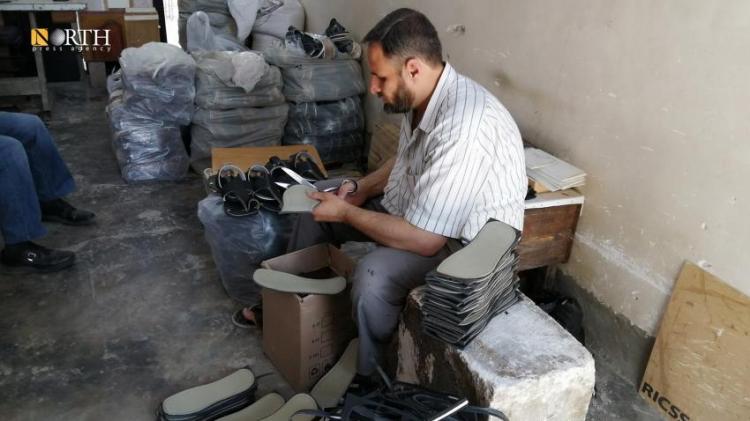Deir ez-Zor – North-Press Agency
Safa’a Amer
For three years, Maher al-Hassoun has been using one of the corners of his house on Nadi al-Dubbat Street in al-Qusour neighborhood in Deir ez-Zor as a place to practice his profession in the manufacture of men's sandals, locally known as klash, which he previously inherited from his father.
His previous shop in al-Jubaila neighborhood in the center of Deir ez-Zor city was destroyed when armed opposition groups took over the area in 2013.
Al-Hassoun learned the manufacture of varieties of the klash since he was ten, where his family passed the profession onto all children and grandchildren, but today he remains the only professional craftsman in his family in the city after the emigration of most of the craftsmen.
A profession in danger of extinction
The klash is one of the symbols of the ancient Euphrates heritage, and a traditional handcraft that does not use any machine when it is made.
Al-Hassoun told North Press that his profession today is in danger of extinction, explaining this that the customers choose fashion and buy modern types of ready-made shoes in the markets.
The klash was transformed from popular shoes used by both the rich and poor sons of Deir ez-Zor city into a valuable gift to be given to relatives and sent to friends in various regions and countries.
Before the war, the klash cost about 150 to 200 SYP, but today the price of a pair of them is about 3,500 SYP due to the high costs of materials used in this industry, according to al-Hassoun.
Difficulties
In earlier periods, al-Hassoun’s career was limited to special requests he received from his customers who appreciated his skill, as he was able to make approximately thirty pairs of shoes in a single day.
“When I returned to manufacturing klash after a break of nearly three years, I felt that I was learning it for the first time, so I recovered everything my father taught me in full detail since I was a little boy," he added.
Al-Hassoun was completely cut off from his work since 2015 after the Islamic State (ISIS) besieged the city of Deir ez-Zor until his return to work after the break of the siege by government forces in 2017.
Types and skill
Manufacturing klash sandals was a well-known profession known in Deir ez-Zor that depended on cowhide and sheepskin, requiring only a sewing machine to embroider the skin and the hands of its skilled craftsmen, whose number decreased year after year.
Al-Hassoun relies on large hand-held scissors, special cutters for leather, tanning, and thick black and white strings.
The first type of klash is called “Hijazi” which is more usable as it is exposed to air and divided into two main parts, the first is for big toe that is in the form of a small arc, while the second is in the form of a diagonal or straight skin roof that covers the rest of the toes.
The second type is called “al-Hajjani”, is the least used, and is open in the front, so that all the toes are together.
“Like any other profession, the profession of manufacturing klash requires patience, accuracy, and focus in addition to great effort," he said.
Al-Hassoun relies on his profession as his sole source of livelihood to support his three children who are studying in primary school. He dreams of a bright future for them, far from what they suffered during the war years.

